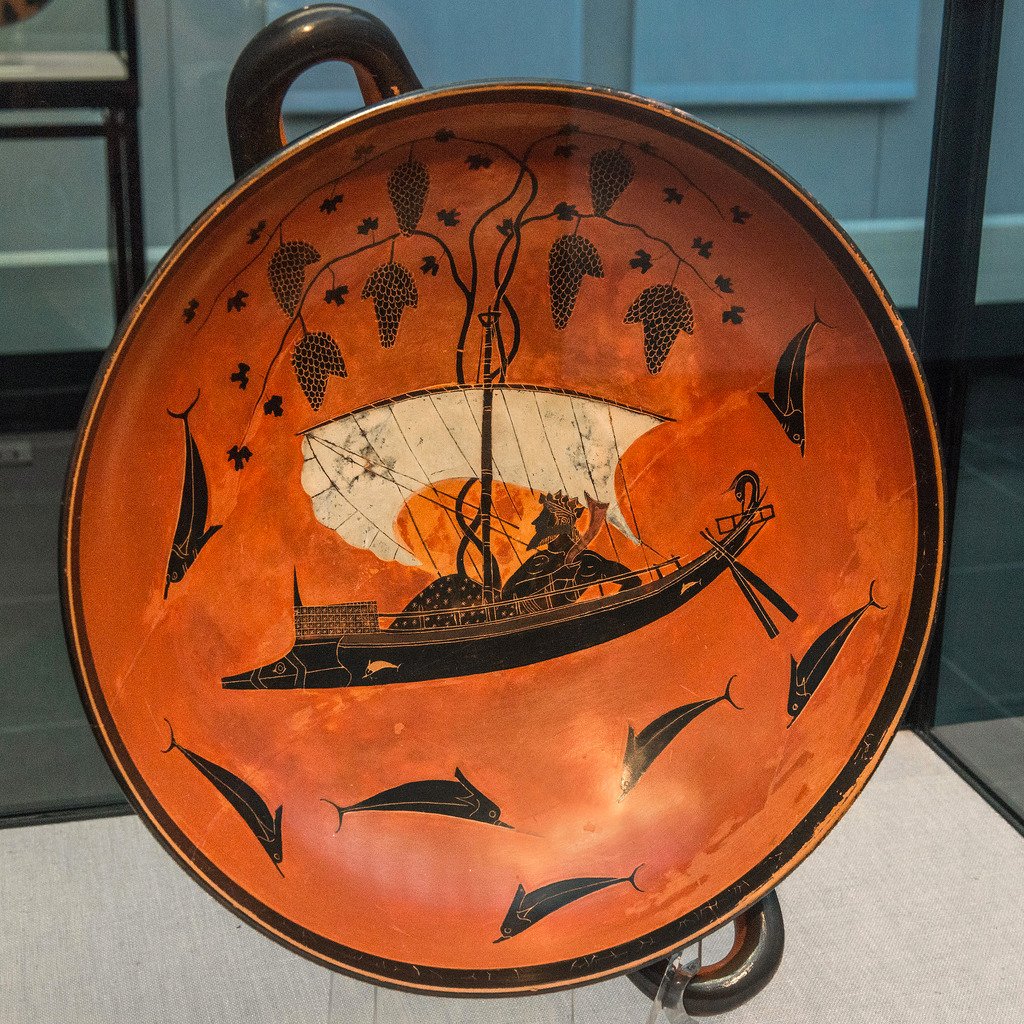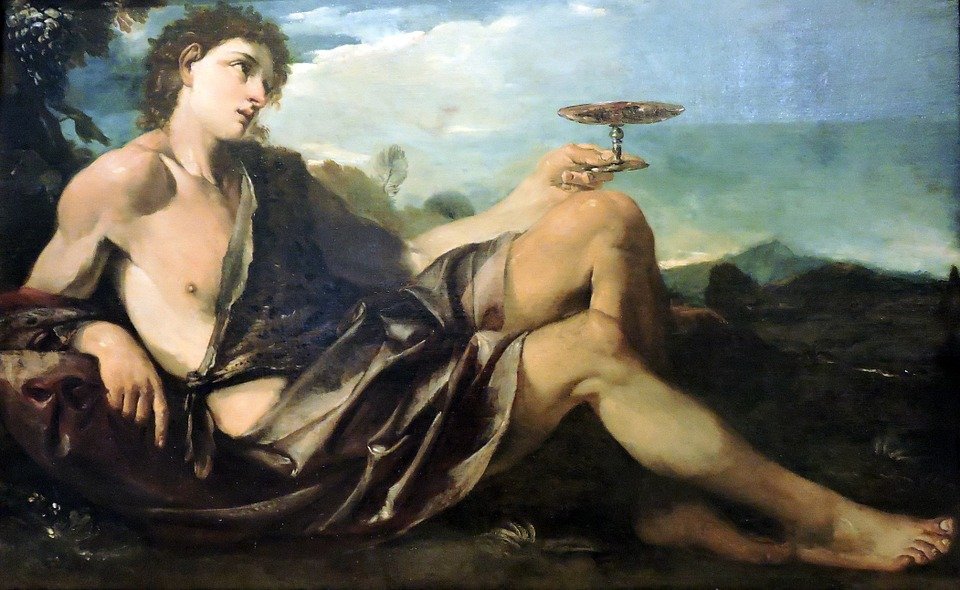Oh, Dionysus. You can be a sweet and understanding fellow, but if you are spited then there is no escape from your mad wrath. This is a cautionary tale, do not spite a god, even if you know not who he is. Listen to your fellow ship-mates, for they may see the divine where you ignore its existence!
Welcome back, friends from the Steemverse. I would like to introduce you to one of my favorite pagan gods, the Greek Dionysus. He goes by many names just like the wine he embodies, such as Bacchus, Zagreus or Liber. He is a most ancient god of wine, theater and of the collective unconscious mind.
I think that art is one of the most magnificent ways to explore ancient history, to see through the eyes of an ancient artist who strove to capture a scene of myth or story with their artistic skill. I in fact have done an extensive project on exploring Dionysus through art, and I would like to share that old project with you, revamped. This way we can come to understand the figure of Dionysus intimately, through many eyes, and from many perspectives.
First, I want to start with one of my most favorite pieces depicting the god and explore a powerful story involving sweet and scary Dionysus in his full glory. Here we will see that he can be vengeful, but also compassionate and understanding. Of all of the gods in the Greek pantheon, he may be the most human-like and therefor shares some of the shortfalls but also benefits of the human perspective.
Let us explore the story of Dionysus and the Tyrrhenian pirates through the beautiful and ancient drinking cup or kylix displaying this myth. This beautiful piece of ancient art was created by Exekias, a somewhat famous and very talented painter and potter from Athens during the archaic age.
He used the black figure technique, which along with red figure pottery techniques were used as fine pottery (as opposed to plain everyday use pottery) and would be used nearly every meal at a wealthy persons dinner table. With black figure vases, the figures and motifs were black and the background was left the color of clay, and artists could articulate the forms with purple or white enhancements of mixed pigment and clay. This piece was created in 530 B.C. and for such a long time ago, it is an incredibly elegant piece. It currently on display in Munich, Germany if you really want to see it!
The technical term for this sort of ancient Greek drinking cup is actually a kylix, which is a wide and shallow drinking cup, usually raised from a stem with a foot on the bottom and two symmetrical handles on the sides, so you could raise this bowl-looking drinking cup to your lips in an elegant manner and taste the wine the god himself embodies.

Now, onto the myth, what does the image on the kylix represent? It will soon become apparent. I have many different sources for this myth, which can mostly be found here. I am going to tell the story in my own words however, with some help from quotations!
The god was standing on the shoreline, overlooking the Mediterranean sea. His deep purple robes billowed in the fresh sea breeze and his dark hair framing his handsome and youthful face. He looked every bit a nobelmans son, or so the pirates thought as they sailed past.
The pirates figured they could get a handsome ransom (or to sell him as a slave) for the handsome man, and so they swooped by and swiftly captured the young man, the god Dionysus in disguise. Of all the gods, Dionysus may indeed be the most mistakable for a human being since he spent so much time amongst men.
The pirates, unknowing of their doom, "sought to bind him with rude bonds, but the bonds would not hold him, and the withes fell far away from his hands and feet: and he sat with a smile in his dark eyes. "
Most of the men on the ship did not realize that this indeed was a heavenly god infront of them, but the helmsman did understand and the realization dawned on him. He cried out "You fools! This is a god we have on this ship, not some mortal man, we must release him and repent or we will meet our doom! ' lest he grow angry and stir up dangerous winds and heavy squalls. '"
But the captain did not heed the helmsmen wise words, instead he mocked him and told the shipmates to set sail and quick! He had greed in his heart, and he did not see the truth. The sail caught a gust of wind, the sheets taught, and off they sailed into the deep blue sea.
However, strange things began to happen. Wine spouted like a spring from many places on the ship, and flowed in streams throughout. Its pleasant aroma and deep red juices nearly hypnotized the pirates, who did not know what to make of it. Grape vines sprouted from the mast, growing and maturing nearly in the blink of an eye and producing flowers and sweet bunches of grapes, the entire life cycle complete in only a moment. At last, the pirates realized this indeed was a god, but it was too late.
That was not all the now angry Dionysus had in store, the god himself transformed into a powerful lion that let loose a terrifying roar. He created the illusions of a bear and a panther, instilling an incredible terror in the pirates who sought to flee over the sides of the ship. The god sprung on the captain of the ship and tore him apart, and all the shipmates who fled into the sea were instantly transformed into dolphins.
Although Dionysus was not pleased, he had mercy on the helmsman who saw through to his divinity and who spoke wisdom to his shipmates at cost to his pride. He spared him from any terrible fate and spoke words to him;
"Take courage, good man; you have found favour with my heart. I am loud-crying (eribromos) Dionysos, son of Semele and Zeus. Hail, child of fair-faced Semele!"
And with that the ordeal is over, and we see the great god Dionysus relaxing on the ship enjoying a cup of wine, vines sprouting from the mast and dolphins gathered around the ship that they once stood on, before they spited a god. For this was no stress for the jovial god of wine, who found both terrifying rage and benevolence within himself at the same time. This is why we see him reclined in his iconic pose as this was no challenge for an immortal.
As you can now see, the kylix represents the ending of a cautionary tale of the wrath of the god of wine. Crazy, unimaginable stuff can happen when you mistake a god for a mortal, and especially when wine flows forth like a spring.
It is not hard to find the message in this story, and it is not hard to see the lesson in being wise and perceptive like the helmsman. He saw through the intoxicating greed and saw the divine. Maybe it can be compared to the dangers of drinking to much wine as well, because crazy things can happen when you get too close to this particular ecstatic god.
Maybe this was a reminder who those who drank out of the cup, because as they drank and raised the cup to their lips the god would slowly become visible. What an effect that must be since the ship would be floating on the deep red wine he symbolizes as you drank, slowly revealing the dolphins and the grapes.
You can hear the smART academy talk about this piece here, a major source for this whole project.
The artist who designed and painted this kylix was of particular genius for having the vision to come up with such an idea, as you became closer to the god of wine with each sip of his sweet and bitter juice. I think that if I drank from this cup, it would be a sort of pious meditation to my most admirable and human-like immortal.
For although Dionysus can have rage, he can also have mercy and compassion. Although the world may not accept him or understand him, he is at peace and relaxed in the forests or at sea. And when it is time to celebrate he can celebrate like no other!
"Hail, fair-faced child of Semele."

Oh, Dionysus, how relaxed you are. Let us escape from this harsh reality and frolic through the woods with him, sipping on bitter-sweet wine and dancing without a care in the world. That is how Dionysus is, and as you sip from his drinking cup you can become even closer to the Dionysian state!
Thank you friends for exploring this ancient god through our imaginations and through the eyes of an artist that lived over 2000 years ago! Dionysus endures through time, and so does his art and his spirit!
Now, off too the film fest I go, to gain knowledge, inspiration and to volunteer. Until next time (hopefully soon), have a lovely day!
Bibliography:
I know a lot of this by heart, and most of it includes my own musings and ideas on the matter, however here is the prezi link to the entire project - be warned, spoilers!
http://prezi.com/leef3wvnsuw0/?utm_campaign=share&utm_medium=copy&rc=ex0share
Images are from pixabay unless otherwise sourced (yes, including that last painting)
http://www.theoi.com/Olympios/DionysosWrath.html#Tyrrhenian
http://www.antike-am-koenigsplatz.mwn.de/en/ancient-masterpieces/museum-highlights/archive-of-museum-highlights/dionysos-cup.html

If you enjoyed this post, do not fret, there is more! Check out these links for more recent and quality posts from @skycae!
The Chipmunks Day Poem - Original Illustrations
Some Shit Occurred - Delegation Updates + Delegatee Winners!
Freedom Challenge - How Do I Express My Freedom?
The Mundane, Medicinal and Magical Primrose
For the Love of Discord! - My Top 2 Discord Groups and Others
AstroHerbology, Bridging Herbs and Astrology (A Free Online Mini Courses)

https://discord.gg/QU8ASsh

https://discord.gg/434kYZ

https://discord.gg/EGGCZuK
